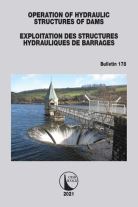Publications

World Register of Dams / Registre Mondial des Barrages
Achat d'un accès de 3ans pour le Registre Mondial des Barrages (RMB).
Le RMB est la meilleure base de données répertoriant des barrages dans le monde et nous travaillons constamment à son amélioration
Registre des barrages
La meilleure base de données mondiale sur les barrages, établie à partir des inventaires nationaux envoyés par les pays membres à la CIGB. Le Registre est mis à jour continuellement et comporte actuellement plus de 55 000 Barrages.
Événements

92ème Réunion Annuelle et Symposium Int'l
New Delhi, Inde
27 Sept. - 3 Octobre 2024
.jpg)
ANCOLD Conference 2024: Never the same dam twice
Adelaide, Australie
11 - 14 Novembre 2024

HYDRO 2024 Secure technology for turbulent times
Messe Congress Graz (MCG), Autriche
18 au 20 Novembre 2024
Voir le site web dédié (en anglais seulement)

17e atelier international de référence de la CIGB sur l'analyse numérique des barrages
Sofia, Bulgarie
9 - 12 Avril 2025

28ème Congrès & 93ème Réunion Annuelle de la CIGB
Chengdu, Chine
15 Mai au 23 Mai 2025

XXIe conférence internationale sur le contrôle technique des barrages
Cracovie, Pologne
09 - 12 Septembre 2025
Voir le site web (en anglais)
Database Presentation

The World Register of Dams is a database of more than 62,000 dams. Two-thirds of them are currently georeferenced.
The World Register of Dams is an essential source of information for design, construction, scientific work and statistical assessments. It gives references on large dams (as defined by ICOLD) around the world. It is one of the pillars of the international dam community and a showcase for the general public. It is of great importance both for the ICOLD and for all those involved in the field.
The Committee responsible for the Register coordinates the centralization of the data provided by ICOLD National Committees. It also incorporates data on dams in countries that are not members of ICOLD. From the year 2023, the register included dams in 166 countries. All the information collected is integrated into the database, after formatting by the Committee of the Register. New versions are posted on a regular basis, roughly on an annual basis.
The data concerns characteristics specific to the dams (year of commissioning, height, length, type, etc.), characteristics relating to the associated reservoirs (volume of the reservoir, area of the reservoir, purposes, etc.), data on the stakeholders (owners, design offices, contractors, etc.) and elements relating to geography (country, river concerned, locality). Since September 2023, the coordinates of the dam expressed by the longitude and latitude of the WGS84 geodetic system are also available when known. All of these elements are provided by the ICOLD National Committees or are extracted from publicly accessible databases or websites.
While every effort is made to avoid data errors, ICOLD cannot guarantee the accuracy of each value or provide missing data. ICOLD, the ICOLD Central Office, the National Committees and the members of the Committee of the Register cannot be held responsible for any errors or omissions that may have occurred.
On the ICOLD website, the database is assisted by a search engine, the operation of which is explained in this document.
The use of the data is the responsibility of the end user. When using the data, in particular in the form of publications, the user is required to indicate their origin by specifying the mention "ICOLD/CIGB – World Register of Dams/Registre Mondial des Barrages – xxx" or xxx represents the version date of the database (indicated at the top of the search engine page).
ICOLD warmly thanks the members of the committee, the ICOLD General Secretariat, all the responsible persons in the National Committees and those who participated in the data collection.
Tags : Central Office











